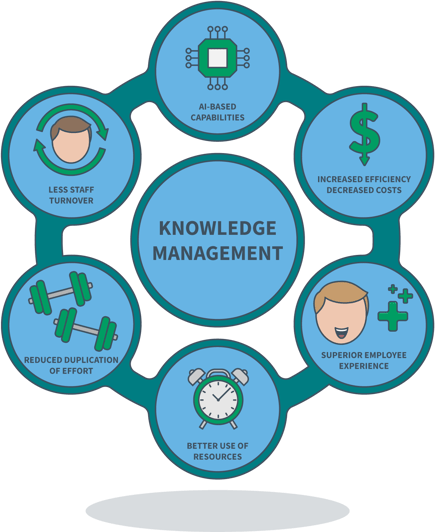EV Blog
Loïc Besnard | September 15, 2020
Future of ITSM: Trends and Predictions
At the beginning of 2020, we made some predictions about the future of ITSM. Of course, there are some things that no one could have ever predicted this year – for example, there was no way to predict the global pandemic and the rapid-fire adoption of digital transformation that followed. However, these often-intense changes, have created a bright future full of opportunity for IT teams across the world.
The future of ITSM is bright, as is the future of digital transformation. As we near the end of 2020 and approach 2021, we have some predictions of upcoming ITSM trends to watch.
What is ITSM
Before we dive into the future of IT service, it is important that we are on the same page as to what ITSM is and what it encompasses.
ITSM is often a catch-all term for the processes of the IT team. The formal definition of ITSM by Axelos as “The implementation and management of quality IT services that meet the needs of the business. IT service management is performed by IT service providers through an appropriate mix of people, process and information technology.”
In other words, ITSM refers to the entirety of activities directed by policies, organized and structured in processes and supporting procedures, that are performed by an organization to design, plan, deliver, operate and control information technology services offered to customers.
ITSM ensures the appropriate mix of people, processes, and technology needed to meet a company’s goals. It organizes the activities of the IT organization to prioritize service delivery and ultimately drives down IT expenses. This is all made possible through IT service management software.
ITSM can also be used enterprise wide as Enterprise Service Management to improve communication between departments. For example, ITSM may be used to submit Facilities or HR requests.
Future of ITSM and IT Operations
We believe the following eight trends and predictions for ITSM will help companies continually innovate – no matter where the pandemic stands.
Enhanced IT support
A major benefit of an ITSM solution is enhancing access to IT Support. The future of ITSM and IT operations will bring the expansion of IT support, and the framework of ITIL will enhance the ability to provide consistent support. ITSM will become the default way to reach the IT department over traditional methods, like email or phone calls, and the move to self-service integration will bring forth a greater shift-left initiative, allowing IT to provide more in-depth support for the problems that cannot be resolved with self-help. Ultimately, this will bring forth better and more thorough IT experience utilizing the same number of people and resources.
Expanded ITSM Automation
Just as enhanced IT support will be brought through ITSM, increased use of automation will be adopted, which leads to a more successful shift-left initiative and ultimately an increased deflection of tickets.
Automation is made from a set of repeatable steps that can be done without human intervention. This can be workflow automation, automatic password resets, or even automated updates within an organization. Overall, automation works to deflect tickets, resulting in the reduction of service desk call volume by as much as 30% and can majorly impact service desk metrics for the better – all of which helps lower costs and increase productivity.
Added IT Chatbot Support
Chatbots are not only the future of ITSM, but the future of communication in general. In fact, Gartner predicted that “by 2020, the average person will have more conversations with bots than with their spouse.” That sounds crazy, right? And yes, maybe it was a little bit far-fetched (especially since many of us have been at home with a spouse during Covid-19 lockdowns). But, with major growth and change in artificial intelligence (AI) technology, chatbots are now able to lend support like never before.
Working with a knowledge management database, chatbots can now access data and knowledge articles, create tickets within the ITSM system, and help users find the right support. Plus, chatbots programmed with a Natural Language Processing (NLP) layer can understand a wider range of people from a variety of regions, making it perfect to support remote workers across the world as they interact with IT support. Additionally, an NLP engine customized to personalize interactions with employees can further brand culture for a better experience and increased user adoption.
Increased Use of Knowledge Management
Knowledge management is the process of creating, sharing, using, and managing the knowledge and information of an organization. It refers to a multidisciplinary approach to achieving organizational objections by making best use of knowledge. Being able to engage users through a contextualized knowledge approach will play a key role not only in the creation of knowledge, but also in its use.
This can be achieved through a knowledge management solution or self-service portals that allows you to go beyond the knowledge article and offer an engaging knowledge experience that will reach anyone within your organization. There are so many benefits to knowledge management including increased efficiency with reduced costs, a superior employee experience, reduced duplication, and so much more. For this reason, knowledge management will only continue to grow in the future.

Improved Customer Service with Speed, Quality, and Cost
Employee and customer experience have always been a prevalent topic in the IT Service Management world. With that in mind, it is unsurprising that the future of ITSM involves the improvement of the customer service experience.
Many organizations are leveraging advanced technologies, including conversational AI and intelligent knowledge management systems, to increase productivity and efficiencies in ITSM. This, along with the use of shift-left strategies (such as using self-help technologies to automate processes) will be critical when it comes to delivering optimal customer and employee experiences. Not only does this speed up the delivery of support for the end-user and customer, but it also improves the quality of services delivered while reducing costs. Not to mention internal customers (employees) have higher levels of satisfaction with a comprehensive ITSM self-service experience.
Increased AI Adoption
AI applications in the consumer world are becoming more common and adoption continues to rise in the B2B space. IT and business leaders are talking more about AI technologies but have challenges when it comes to developing and implementing the right AI applications for ITSM tools. This is why we should look at specific AI technologies than supplement ITSM rather than AI as a whole.
For example, conversational AI, which powers messaging applications like chatbots, can automate intelligent conversations between your customers and virtual support agents. The development of AI technology will also lead to better knowledge insights in the form of recommendations and predictive analytics. The coming months will bring a wave of AI adoption with more emphasis on personalization and accessing unique bits of knowledge specific to each user.
Invigorated IT Efficiency
Reducing costs and expenditures and optimizing budgets is going to be the name of the game going forward in a post-COVID world. In order to keep organizations running smoothly, the IT team must work to improve efficiency and optimize technology. This will be brought about by the methods mentioned above, for example ITSM software improves IT efficiency by enabling a shift-left initiative and by more easily escalating tickets when needed. Overall there will be a much higher focus on improved IT efficiency than ever before.
Greater Focus on HR Support with Enterprise Service Management
Using ITSM as an Enterprise Service Management solution, HR support can be as easy as IT support. Tickets for time off requests, benefits questions, and other HR-related issues can be submitted through a self-help portal in the same manner of IT requests. This also supports the shift of focus onto the overall wellbeing of employees that we have seen in 2020. When it comes to people, it is important to provide them with the right work environment that will not only make them more productive but will take care of them in the long run – which can be made easier with an ESM solution.
Focus on the Enterprise
In some respects, there is much that remains to be seen for 2020 and beyond, but one prediction that will ring true regardless of what happens in the next year is the growth of the digital revolution. As employees remain working remotely, the need for an enterprise-wide solution will only grow.
To learn more about how IT service management can lower costs and increase efficiency for your enterprise, click here to get a personalized demo.
Subscribe to Email Updates
Loïc Besnard
Loïc Besnard serves as Senior Director of Product Marketing and Head Technical Evangelist at EasyVista. Besnard served as Global Pre-Sales Director of EasyVista until January 2017. He joined EasyVista in 2009 and is responsible for EasyVista’s worldwide pre-sales engineering strategy. With over 15 years of experience in the IT industry and international technical sales, Besnard supports EasyVista’s growth, international development and technical sales operations.





